On October 12, 2018, the European Commission issued Regulation (EU) 2018/1513, which is classified as carcinogenic, genetic mutation, and reproductive toxicity (CMR) 1A in the EU REACH Regulation (EC) No 1907/2006 Annex XVII And 1B related to clothing and related accessories, textiles and footwear products in direct contact with the skin to make regulations. According to the regulations, these substances will be added to Article 72 of Appendix XVII, and Annex 12 will be added at the same time. The regulations will be implemented on November 1, 2020.
In order to promote the orderly development of the UV disinfection lighting market and better promote the healthy growth of UV disinfection lighting products, on August 3, China Quality Certification Center (CQC) launched the UV disinfection lighting safety and performance certification business through research and development.
?LED is an energy-saving and emission-reducing product. Whether it is used for LED encapsulation or finished LED lighting, if your product does not pass the corresponding certification, then the product will be lowered and the product will be The sales have become a major impact. The following are some common certifications about LED products collected by ZRLK from the Internet. If there is any omission or improper point, it is only for your reference!
With the development of the North American epidemic and the increasing demand for sterilization, disinfection, insect repellent, and mosquito-killing electrical products and equipment in the post-epidemic era, more and more disinfection and antibacterial appliances, air sterilization equipment, and non-insect and mosquito-repellent Large quantities of electrical products or equipment for medical purposes are exported to the United States. In accordance with the requirements of the Federal Insecticide, Fungicide and Rodenticide Act (FIFRA: Federal Insecticide, Fungicide and Rodenticide Act), electrical products such as sterilization, disinfection, insect repellent, and mosquito control are all within the scope of EPA control. Therefore, the majority of manufacturers and sellers need to pay special attention to the specific control requirements of EPA to avoid being denied entry when the goods enter the US customs.
On May 15, 2020, the European Commission issued the European Commission Executive Decision (EU) 2020/6591 to harmonize the standard EN IEC 63000:2018-Evaluation of technical documents related to the restriction of hazardous substances in electrical and electronic products (IEC 63000:2016), It replaces the technical document harmonization standard EN 50581:2012 to ensure compliance assessment of the 2011/65/EU (RoHS 2) directive. The previous EN 50581:2012 standard will be withdrawn on November 18, 2021.
On July 21, 2020, South Korea KC issued a new announcement 2020-0138, which officially established and abolished the Korean battery standard.
The basic requirements for the transportation of lithium batteries: (1) Lithium batteries and lithium battery packs are classified as Class 9 dangerous goods; (2) All lithium batteries (groups) must pass the UN38.3 test; (3) Some Class 9 dangerous goods Exceptions are provided for the transportation of lithium batteries; (4) Strict restrictions on transportation samples; (5) Restrictions on daily-use lithium batteries carried by passengers; (6) Restrictions that all defective or damaged batteries are prohibited from being transported.
Types of batteries tested: nickel-metal hydride batteries, nickel-cadmium batteries, alkaline manganese batteries, fuel cells, dry batteries, button batteries, lithium ion batteries, mobile phone lithium batteries, import and export batteries, notebook batteries, and two batteries containing alkaline or non-acid electrolytes Secondary cell; Test items: impact test, height simulation test, overcharge test, temperature test, forced discharge test, external short circuit test. Impact test, vibration test.
Learn the latest exciting content
